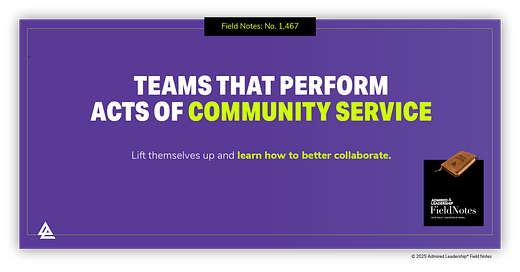Of the many teambuilding activities available to organizations, perhaps none is as powerful as team members performing a community service together.
Meaningful causes within the local community where team members work are plentiful. Good leaders rally the troops and agree to a community project that will make a difference in people’s lives.
An ideal act of service combines teamwork, problem-solving, and focused effort. The service fosters a sense of purpose and collective achievement, motivating team members to work together toward a common goal.
While seeing the direct impact of their efforts on people’s lives can boost morale and reinforce the importance of teamwork, the real benefit is the unity it creates.
Acts of service can significantly strengthen team dynamics and foster a sense of belonging. Team members learn to break down barriers, communicate effectively, and coordinate their actions.
Because it involves helping others and does not focus on the everyday work of the organization, team members drop any pretense and build camaraderie.
The key to such activities is to find a project everyone on the team wants to contribute to. Everyone must engage. No one can sit on the sidelines or choose not to contribute.
Full engagement by everyone on the team cultivates a positive climate that reinforces the importance of teamwork and allows team members to feel prideful of what they accomplish.
Most leaders have heard of such opportunities as Habitat for Humanity, where team members help people to build or improve the place they call home.
They also know of activities like operating food banks and mentoring underprivileged youth. But the possibilities go well beyond what is typically thought of.
Consider this shortlist of activities: Vaccination drives and sponsoring health fairs, fostering animals awaiting adoption, disaster preparation, creating community gardens, revitalizing local parks, planting trees, supporting literacy and reading, organizing sports tournaments, running recreational opportunities for local youth, collecting and donating winter clothing, manufacturing and distributing hygiene products, assisting elderly residents in nursing homes, creating public art to beautify neighborhoods, assembling furniture, building bicycles, running a music festival, installing solar panels, and setting up community recycling and composting programs. The list goes on.
Good people want to help other good people. Your team is ready and willing to do their part to contribute to the local communities in which they live and work.
Leaders who facilitate acts of service build teams in the process. When team members use their talents to serve the community, they lift themselves up and learn how to better collaborate.
Now that’s a Win-Win.





In this post, I hear traits of humility and serving portrayed in active, stewarding applications. Excellent!
Good stuff.